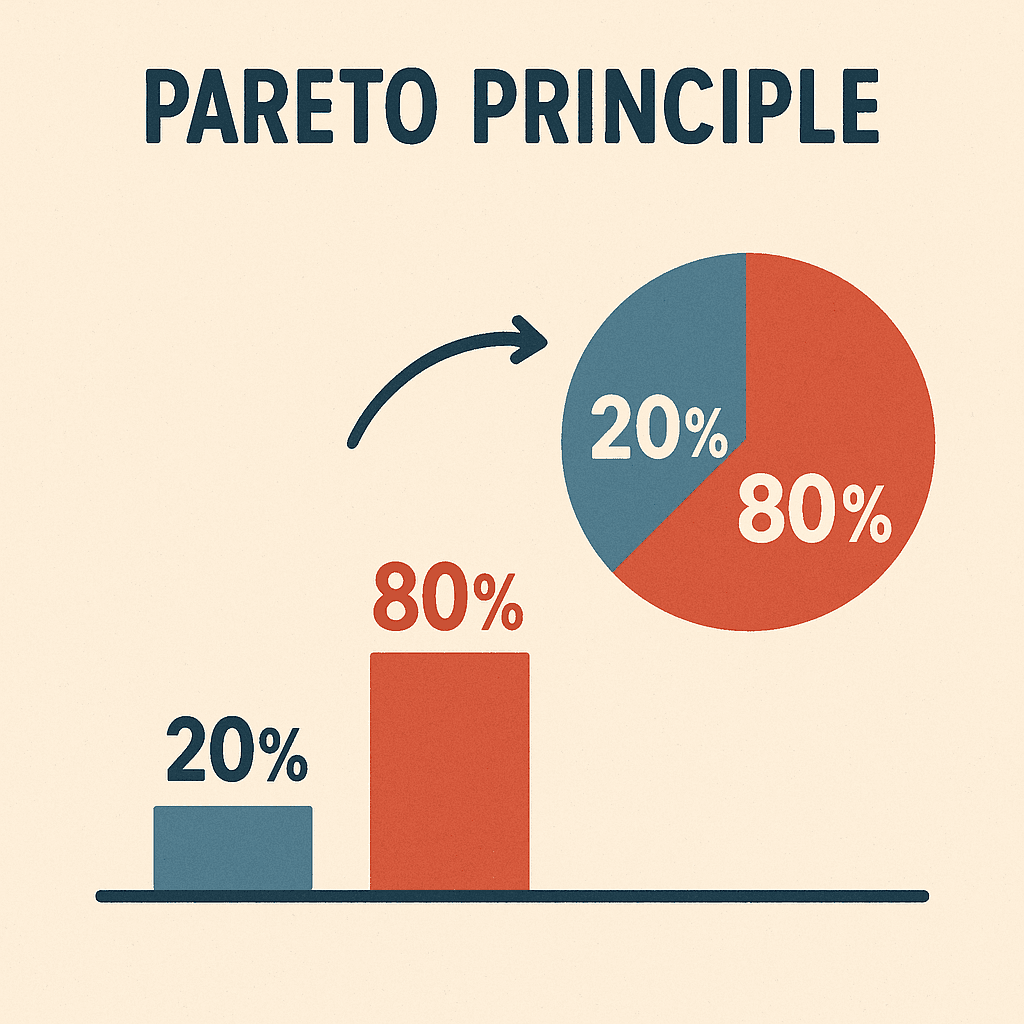Imagine if 20% of your efforts could deliver 80% of your results. Does the pareto principle really let you focus on what truly matters? The answer could transform how you work and live.
The 80/20 rule starts with Vilfredo Pareto’s 1906 discovery. He found that 80% of Italy’s land was owned by 20% of its population12.
The pareto principle shows up everywhere: 20% of customers drive 80% of sales2, and 20% of design flaws cause 80% of car crashes1. It’s not just math—it’s a mindset.
Key Takeaways
- 80% of outcomes often stem from 20% of causes (the 80/20 rule)1.
- Pareto’s original observation tracked wealth and land distribution in Italy12.
- Businesses use it to prioritize high-impact actions, like focusing on top clients2.
- It applies to daily life—from wardrobe choices to software bug fixes2.
- Not a strict formula, but a tool to identify critical factors1.
Understanding the Pareto Principle Concept
The Pareto principle reveals that a small part of the input leads to most of the output. Let’s dive into its beginnings and how it affects our world.
The Origin of the Pareto Principle
Italian economist3 Vilfredo Pareto discovered the 80/20 rule in the 1890s. He studied land ownership in Italy and found that 20% of families owned 80% of the land3. Later, Joseph Juran, a management expert, built on this idea to create the pareto distribution model we use today.
Key Statistics and Findings
- Healthcare: 20% of patients use 80% of resources3.
- Software: Fixing 20% of bugs stops 80% of crashes4.
- Economy: The richest 20% globally hold 82.7% of income3.
“Ask: ‘What’s the 20% in this situation that will deliver most results?’ to cut through clutter.”
Application in Everyday Life
Think about your wardrobe. Maybe 20% of your clothes get 80% of the wear4. Or, 20% of your tasks do 80% of the work4. Spotting these patterns helps you focus better. The principle of least effort helps save mental energy5.
The pareto principle isn’t set in stone. Ratios like 90/10 also show up5. The goal is to find the most impactful areas to boost efficiency.
How the Pareto Principle Works
The principle of least effort is at the heart of the Pareto Principle. It guides systems to paths that need the least energy6. By focusing on the critical 20%, you get efficient allocation of time, money, and effort.
Let’s see how this works in real life.
The 80/20 Rule Explained
Vilfredo Pareto first saw this imbalance in his pea garden. He found 20% of the pea pods gave 80% of the harvest6. This pareto principle is a guide, not a strict rule. For example, Microsoft found that 20% of bugs caused 80% of software crashes7.
The exact ratio is less important than finding key areas. Dr. Joseph Juran used it in quality control. He showed that 20% of defects caused 80% of product issues7.
Real-Life Examples of the 80/20 Rule

- Customer service: 20% of clients create 80% of support tickets7.
- Marketing: 20% of content generates 80% of website traffic8.
- Sales: 20% of products account for 80% of revenue6.
- Teams: 20% of team members drive 80% of project results8.
Retailer Carla increased blog traffic by 220% by focusing on the top 20% of readers6. Even team leaders use it to find star performers and assign tasks wisely8.
The pareto principle is not just a math formula. It’s a tool to find where your efforts bring the most value. Start tracking your efforts today and find the vital 20%.
Implementing the Pareto Principle in Your Life
Change your daily life with the 80/20 rule. Ask yourself, “Does this task help my main goals?” Focus on the 20% of tasks that give you 80% of your results9
“Extraordinary success is sequential, not simultaneous.”
Start with a productivity strategy based on the pareto principle. Make a list of tasks and mark the top 20% that matter most. For example, if 20% of clients bring in 80% of your income, focus on them10.
Use a four-column Pareto table to see which tasks are most impactful9.
- Find your “vital few” tasks every day with the 80/20 rule.
- Use apps like Trello or Notion to see your key tasks.
- Check your progress weekly to adjust your focus.
Begin with a small step: track your time and results for a week. You’ll likely find that 20% of your effort leads to 80% of your success9. Apply this productivity strategy to both work and personal goals.
The Pareto Principle is about focusing on what’s most important, not doing less. Learn more about aligning your efforts with your priorities. Every choice should ask: does it fall in the critical 20%?
Benefits of Using the Pareto Principle
The Pareto Principle, or 80/20 rule, helps business optimization by showing the 20% of efforts that produce 80% of results Pareto Principle. By focusing on these key areas, teams save time and increase output. For example, 20% of customers often bring in 80% of profits, helping guide where to put resources11.
This approach also follows the principle of least effort, aiming for maximum results with minimal effort.

“Find a judo solution, one that delivers maximum efficiency with minimum effort.” — Jason Fried, Author of Rework
Increased Productivity and Efficiency
By focusing on the 20% of tasks that drive 80% of results, productivity soars.
A study found 80% of revenue comes from 20% of products12, helping businesses concentrate on their best offerings. Teams using this productivity strategy reduce time on low-value tasks by up to 40% and focus on what matters most11.
For instance, fixing 20% of code causing 80% of system errors can greatly improve development13.
Better Decision-Making
Decisions become clearer when using the 80/20 rule. Teams pinpoint the 20% of decisions that impact 80% of outcomes, reducing uncertainty. A manufacturing firm might tackle the 20% of defects causing 80% of product failures11, cutting down on waste.
This focus aligns with business optimization goals, ensuring decisions are strategic.
Enhanced Focus and Clarity
Discarding low-priority work brings clarity. By focusing on the 20% of daily tasks that yield 80% of value11, distractions are reduced. For example, a manager might focus on the 20% of clients needing 80% of support11, opening up time for growth. Using this approach reduces decision fatigue, allowing you to focus on what’s truly important.
Common Misconceptions About the Pareto Principle
The Pareto Principle can be very helpful, but it’s often misunderstood. This can make it less useful. Let’s clear up these misconceptions so we can use it effectively.
Misunderstanding the 80/20 Ratio
The 80/20 ratio isn’t a strict rule. For example, in healthcare, 20% of patients use 80% of resources14. But in other areas, the numbers might be different. The key is to focus on what really matters, not the exact numbers.
Pareto analysis is about finding the most important factors. It’s not about following a strict formula15.
Overgeneralization of the Principle
Using the 80/20 rule without thinking can be harmful. Illinois Tool Works saw big gains from it14. But, it might not work for creative work or team dynamics. It’s important to consider each situation carefully.
For instance, 20% of clients might bring in 80% of sales16. But ignoring smaller clients could hurt your business in the long run. It’s all about finding the right balance.
Situations Where It May Not Apply
In fields where safety is key, even rare risks must be considered. A software team might fix 20% of bugs that cause 80% of problems16. But, ignoring small bugs in medical devices could be dangerous.
Pareto analysis works best when used with common sense. For example, in disaster planning, 20% of events cause most damage14. But, not every situation fits this pattern. It’s a guide, not a rulebook.
By avoiding these common mistakes, you can use the Pareto Principle to improve your business. Just remember to stay flexible and let data guide your decisions.


